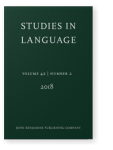Vol. 42:2 (2018) ► pp.297–328
On the Formation of Modern Chinese Pseudo-Possessive-Object Constructions
Modern Chinese Pseudo-Possessive-Object Constructions (shortened as Modern Chinese PPO constructions; e.g. ta shuo le wo de haohua (他说了我的好话) ‘he has put in a good word for me’ and ta chi le wo de doufu (他吃了我的豆腐) ‘he has taken advantage of me’) are actually constructions displaying possessor-affectee syncretism. They derive from Early Modern Chinese Real-Possessive-Object constructions in bridging contexts, some examples being wo ye quande liewei daren de jiu (我也劝得列位大人的酒), ‘I also urged all the magistrates here to finish drinking your wine’ and shi nage zai jie wo de duan li (是那个在揭我的短哩) ‘who is uncovering my demerits’. Di-transitive constructions in Middle Chinese and Early Modern Chinese (e.g. Changxing! quan er yibei jiu (长星,劝尔一杯酒) ‘Comet! I urge you (to finish drinking) a cup of wine’ and shuru gan jie wu duanchu (竖儒敢揭吾短处) ‘how dare the Confucius scholar uncover my demerits’) have provided structural templates for the formation of Modern Chinese PPO constructions. They also have led to a condition in which there are more examples of a maleficiary Modern Chinese PPO construction than examples of a beneficiary Modern Chinese PPO construction (e.g. ta chi le wo de doufu (他吃了我的豆腐) ‘he has taken advantage of me’ vs. ta shuo le wo de haohua (他说了我的好话) ‘he has put in a good word for me’). The grammaticalization pathway can also explain the formation of other constructions including another Modern Chinese PPO construction (e.g. ta chi le wo de kui (他吃了我的亏) ‘he has suffered the loss caused by me’), a Modern Chinese pseudo-object construction (e.g. wo ganxie ni de haoxin (我感谢你的好心) ‘I thank you for your kindness’), and a Modern Chinese pseudo-modifier construction (e.g. wo pa le yi xiawu de shan (我爬了一下午的山) ‘I did mountain-climbing for the whole afternoon’).
Article outline
- 1.Introduction
- 2.Previous works
- 2.1The Formal perspective
- 2.2The functional perspective
- The semantic role of np3
- Reference of np3
- 3.Cross-language observations of constructions displaying possessor-affectee syncretism
- 3.1Synchrony: Features of constructions displaying possessor-affectee syncretism
- 3.2Diachrony: Formation of constructions displaying possessor-affectee syncretism
- 4.Discussion
- 4.1Comparison between Modern Chinese PPO constructions and constructions displaying possessor-affectee syncretism
- Synchronic comparison
- Diachronic comparison
- 4.2Syntactic motivation for the formation of Chinese PPO constructions
- 4.3Analogical motivation for the formation of PPO constructions in Early Modern Chinese
- 4.1Comparison between Modern Chinese PPO constructions and constructions displaying possessor-affectee syncretism
- 5.Predictions
- 5.1Formation of the other PPO constructions in Early Modern Chinese
- 5.2Formation of a Modern Chinese pseudo-object construction
- 5.3Formation of a Modern Chinese pseudo-modifier construction
- 6.Conclusion
- Notes
-
References -
Primary references
